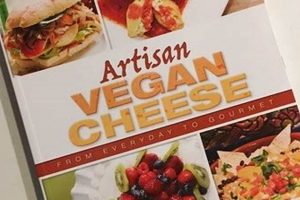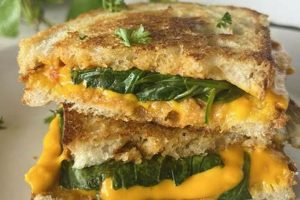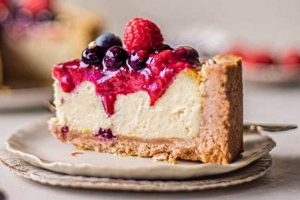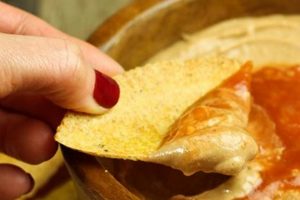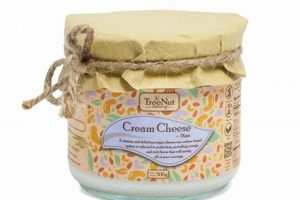A savory tart, typically featuring a custard-like filling baked in a pastry crust, is modified to exclude all animal products. This variation substitutes dairy-based ingredients, such as eggs and cheese, with plant-derived alternatives. Common substitutes include tofu, cashews, nutritional yeast, and plant-based milks to achieve a similar texture and flavor profile. The result is a dish that emulates the traditional form while adhering to dietary guidelines.
This adaptation offers several benefits. It provides a cruelty-free alternative for those following a plant-based diet. It can also be a suitable option for individuals with lactose intolerance or dairy allergies. Furthermore, ingredients often utilized in this dish may offer nutritional advantages, contributing to a balanced diet by including sources of protein, vitamins, and minerals. The development of plant-based alternatives to traditional dairy products has enabled wider accessibility of this type of food across various dietary preferences.
Subsequent sections will delve into specific aspects, exploring recipe variations, ingredient selection, and preparation techniques. Further discussion will highlight the potential nutritional value and comparative analysis against conventional recipes. The objective is to provide a thorough understanding of this culinary creation, addressing both the practical and nutritional implications.
Essential Preparation Tips
Achieving optimal results requires careful consideration of various factors. These guidelines aim to enhance the final product’s flavor, texture, and overall appeal.
Tip 1: Selecting the Right Cheese Substitute: The type of cheese alternative significantly impacts the flavor and texture. Consider using a blend of nutritional yeast for a cheesy flavor, blended cashews for creaminess, and firm tofu for structure. Experimentation is encouraged to determine the preferred combination.
Tip 2: Preparing the Crust Properly: Blind-baking the crust before adding the filling prevents a soggy bottom. Ensuring the crust is adequately pre-baked creates a stable foundation for the custard.
Tip 3: Mastering the Custard Base: Blending the tofu-based or cashew-based custard until completely smooth is crucial. Any lumps will affect the final texture. A high-powered blender is recommended for optimal smoothness.
Tip 4: Seasoning Adequately: The custard base often requires assertive seasoning to mimic the savory profile of dairy-based counterparts. Black salt (kala namak) can impart an eggy flavor, while a combination of herbs and spices enhances the overall taste.
Tip 5: Achieving the Right Baking Temperature: Baking at a moderate temperature (around 350F or 175C) allows the custard to set evenly without cracking. Monitoring the internal temperature with a thermometer is recommended to ensure it reaches the appropriate level of doneness.
Tip 6: Allowing Adequate Cooling Time: Cooling the final product before slicing is crucial for structural integrity. The custard continues to set as it cools, resulting in cleaner slices and improved texture.
Tip 7: Consider additions to enhance flavors: Vegetables, caramelized onions, mushrooms and spinach are excellent additions that can enhance the flavor to provide savory and healthy options.
By adhering to these guidelines, one can create a delectable and visually appealing dish suitable for various occasions. Proper preparation techniques are key to success.
The following sections will elaborate on ingredient sourcing and offer detailed recipe instructions to guide the process further.
1. Crust Integrity
Crust integrity represents a foundational element in the successful preparation of a vegan cheese quiche. Its primary function is to provide structural support for the filling while contributing to the overall textural experience. A compromised crust undermines the entire dish, leading to a less palatable outcome. Therefore, careful attention to crust preparation is paramount.
- Blind Baking Technique
Blind baking, the process of pre-baking the crust before adding the filling, is crucial for maintaining its integrity. This technique prevents the filling’s moisture from seeping into the crust, resulting in a soggy base. Pie weights or dried beans are commonly used to weigh down the crust during this process, ensuring it retains its shape and does not puff up unevenly. Without blind baking, a vegan cheese quiche is highly susceptible to structural failure.
- Gluten Development in Vegan Crusts
Many vegan crust recipes rely on wheat flour, which contains gluten. However, overworking the dough develops too much gluten, resulting in a tough crust. Therefore, mixing the dough until just combined is recommended. Some recipes utilize alternative flours, such as almond or gluten-free blends, which have different gluten-forming properties. Adjustments to technique are often necessary when using these alternatives.
- Fat Content and Flakiness
The type and amount of fat used in the crust significantly impact its flakiness. Cold, solid fats, such as vegan butter or shortening, are ideal for creating flaky layers. The fat coats the flour particles, preventing them from fully hydrating and developing gluten. As the crust bakes, the water trapped within the fat evaporates, creating steam that separates the layers and results in a flaky texture. Insufficient fat or using melted fat leads to a dense, less desirable crust.
- Cooling and Handling
The crust’s integrity is also affected by its handling after baking. Allowing the baked crust to cool completely before adding the filling minimizes the risk of cracking or breaking. A warm crust is more fragile and prone to damage. Proper cooling allows the gluten structure to set, providing greater stability. Furthermore, careful handling during filling and subsequent baking prevents unnecessary stress on the crust’s structure.
The collective impact of these facets demonstrates the critical role crust integrity plays in the overall success of a vegan cheese quiche. From preventing sogginess through blind baking to managing gluten development and fat content, each element contributes to a structurally sound and texturally pleasing base. A well-prepared crust not only enhances the eating experience but also elevates the visual appeal of the final product.
2. Cheese Alternative
The cheese alternative is a pivotal component in the creation of a vegan cheese quiche, directly determining its flavor, texture, and overall success in emulating the conventional dairy-based dish. The absence of dairy necessitates the use of plant-derived substitutes capable of replicating the creamy, savory qualities typically associated with cheese. The selection of the cheese alternative is not merely a substitution; it is a defining characteristic that shapes the final product’s culinary profile. Failure to choose an appropriate alternative results in a dish that deviates significantly from the expected standards, potentially compromising its appeal.
Several types of cheese alternatives are commonly employed. Tofu, particularly firm or silken varieties, serves as a versatile base due to its neutral flavor and ability to absorb seasonings. Cashews, when blended into a smooth cream, offer a rich, decadent texture. Nutritional yeast provides a distinct umami flavor, often described as cheesy or nutty. Commercial vegan cheeses, frequently composed of plant-based oils, starches, and proteins, offer convenience and varying degrees of flavor fidelity. Real-world examples showcase the diverse applications: a cashew-based alternative might lend itself to a richer, more luxurious filling, while a tofu-based version offers a lighter, more versatile option for incorporating additional vegetables. The practical significance lies in understanding these properties to tailor the cheese alternative to specific flavor profiles and textural goals.
Ultimately, the success of a vegan cheese quiche hinges on the strategic selection and preparation of the cheese alternative. The process extends beyond simple substitution, requiring careful consideration of the desired flavor, texture, and functional properties within the overall composition. Challenges may include achieving the appropriate melt, browning, or binding properties without dairy. The chosen alternative must also complement other ingredients, contributing to a cohesive and palatable dish. Understanding the nuances of cheese alternatives and their interaction with other components is paramount for creating a satisfying vegan cheese quiche.
3. Custard Consistency
Custard consistency is paramount to the successful creation of a palatable vegan cheese quiche. The custard serves as the primary filling, lending the dish its characteristic texture and richness. Achieving the correct consistency, a smooth, creamy, yet firm structure, is contingent upon careful ingredient selection and precise preparation techniques. The absence of eggs, a key binding agent in traditional custard, necessitates alternative methods for achieving the desired result. Improper custard consistency results in a quiche that is either overly liquid or excessively dense, detracting significantly from the eating experience. A runny custard, for instance, renders the quiche structurally unstable, while an overly firm custard lacks the desired creamy mouthfeel.
The primary determinants of custard consistency include the selection of plant-based ingredients, blending techniques, and baking parameters. Tofu, cashews, and plant-based milks are common base ingredients, each contributing unique textural properties. For example, silken tofu yields a softer custard, while firm tofu provides greater structure. Thorough blending is crucial to eliminate lumps and create a smooth base. Baking temperature and time directly influence the setting of the custard; excessive heat can lead to cracking or over-coagulation, while insufficient baking results in an undercooked center. Furthermore, stabilizers such as cornstarch or tapioca starch can be incorporated to enhance thickening and prevent separation during baking. Consider a scenario where a cashew-based custard is under-blended, resulting in a grainy texture; this illustrates the direct impact of preparation on the final product.
In summary, custard consistency is a critical factor influencing the overall quality of a vegan cheese quiche. It requires a delicate balance of ingredient selection, precise blending, and controlled baking conditions. Deviations from optimal parameters can result in undesirable textural outcomes. The ability to achieve a smooth, creamy, and structurally sound custard is essential for creating a satisfying and visually appealing vegan cheese quiche. Mastery of custard consistency techniques is, therefore, a cornerstone of vegan quiche preparation.
4. Flavor Profile
The flavor profile of a vegan cheese quiche represents a critical factor in its palatability and acceptance as a substitute for its dairy-based counterpart. Achieving a satisfying and complex flavor requires a strategic approach to ingredient selection and preparation, compensating for the absence of traditional dairy components.
- Umami Enhancement
Umami, often described as a savory or meaty taste, plays a significant role in replicating the depth of flavor found in traditional quiches. Ingredients like nutritional yeast, dried mushrooms, and tomato paste are frequently incorporated to boost the umami content. Nutritional yeast, in particular, is valued for its cheesy, nutty flavor, while mushrooms contribute an earthy note and tomato paste adds a subtle sweetness and depth. The strategic use of these ingredients can create a more robust and satisfying flavor profile that mimics the complexity of dairy cheese.
- Herb and Spice Integration
The judicious use of herbs and spices is essential for enhancing the overall flavor. Fresh herbs such as thyme, rosemary, and chives provide aromatic complexity, while spices like garlic powder, onion powder, and smoked paprika add depth and warmth. Black salt (kala namak), a volcanic salt, can impart an eggy flavor, addressing a common missing element in vegan quiches. Experimentation with different combinations allows for the creation of nuanced flavor profiles tailored to specific preferences. For example, a Mediterranean-inspired quiche might incorporate oregano, basil, and sun-dried tomatoes.
- Fat Content and Mouthfeel
Fat contributes significantly to the mouthfeel and richness of a quiche. Vegan recipes often utilize ingredients like cashews, coconut milk, or avocados to provide the necessary fat content. Cashews, when blended into a creamy sauce, offer a decadent texture, while coconut milk adds richness and a subtle sweetness. Avocados contribute a smooth, buttery consistency. The careful selection and proportioning of these ingredients are crucial for replicating the satisfying mouthfeel of a traditional quiche.
- Acidic Balance
Acidity balances the richness of the other flavors and adds brightness to the overall profile. Ingredients like lemon juice, apple cider vinegar, or balsamic vinegar are commonly used to achieve this balance. A small amount of acid can cut through the richness of the fat and umami, preventing the quiche from tasting heavy or one-dimensional. The specific acid source should complement the other flavors in the quiche; for example, lemon juice pairs well with fresh herbs, while balsamic vinegar complements earthy vegetables.
The successful development of a compelling flavor profile in a vegan cheese quiche depends on the synergistic interplay of these elements. Strategic enhancement of umami, thoughtful integration of herbs and spices, careful management of fat content, and the inclusion of an acidic balance contribute to a culinary experience that rivals its dairy-based counterpart. The ability to skillfully manipulate these facets enables the creation of a diverse range of vegan quiches, each offering a unique and satisfying flavor profile.
5. Baking Process
The baking process is a critical determinant in the final outcome of a vegan cheese quiche, impacting its texture, structure, and overall appeal. Precise control over temperature and time is paramount, given the unique properties of plant-based ingredients compared to traditional dairy-based recipes. The interaction between heat and the vegan custard determines its ability to set properly and achieve a desirable consistency.
- Temperature Control
Maintaining the correct oven temperature is essential. Too high a temperature can lead to cracking of the custard and over-browning of the crust, while too low a temperature may result in an undercooked, soggy filling. A moderate oven temperature, typically between 325F (160C) and 350F (175C), is generally recommended. Some recipes may benefit from an initial higher temperature to set the crust, followed by a lower temperature to gently cook the custard. Monitoring the oven temperature with a reliable thermometer ensures accuracy.
- Baking Time
The duration of baking directly affects the custard’s set. Overbaking can cause the custard to become dry and rubbery, while underbaking results in a liquid, unstable filling. Baking time varies depending on the recipe, oven, and the specific ingredients used, but generally ranges from 45 minutes to an hour. The quiche is typically done when the edges are set and the center has a slight jiggle. A toothpick inserted into the center should come out mostly clean, though a small amount of moistness is acceptable.
- Steam and Humidity
Introducing steam into the oven during the initial phase of baking can improve the texture of the crust and prevent it from drying out. This can be achieved by placing a pan of hot water on the bottom rack of the oven. The steam creates a moist environment that promotes even baking and prevents the crust from becoming overly browned. Some recipes may also call for covering the quiche with foil during the first part of baking to prevent excessive browning, then removing the foil for the final minutes to allow the top to set and lightly brown.
- Cooling Process
Allowing the quiche to cool gradually after baking is crucial for its structural integrity. A rapid temperature change can cause the custard to contract and crack. The quiche should be allowed to cool in the oven with the door slightly ajar for about an hour, then transferred to a wire rack to cool completely. This slow cooling process allows the custard to set fully and prevents the crust from becoming soggy due to condensation.
The nuances of the baking process exert a significant influence on the final characteristics of a vegan cheese quiche. From precise temperature and time management to controlling steam and ensuring gradual cooling, each element contributes to a cohesive and texturally pleasing result. The careful execution of these steps elevates the dish, allowing it to emulate the qualities of its conventional counterpart.
6. Ingredient Synergy
Ingredient synergy in vegan cheese quiche refers to the harmonious interaction of diverse components, resulting in a final product that surpasses the sum of its individual parts. The absence of traditional dairy and eggs necessitates a careful selection and combination of plant-based ingredients to replicate the desired flavor, texture, and structural integrity. Therefore, the strategic pairing of ingredients to maximize their complementary effects is crucial for a successful outcome. Each ingredient’s contribution, whether textural, flavorful, or functional, must align with and enhance the others to create a cohesive and satisfying culinary experience. For example, the combination of nutritional yeast, blended cashews, and lemon juice emulates the cheesy, creamy, and tangy profile of a dairy-based quiche, achieving a synergistic flavor that no single ingredient could provide alone. Without this coordinated interaction, the quiche may lack depth of flavor or possess an undesirable texture.
The practical application of ingredient synergy extends beyond flavor mimicry. It also impacts the quiche’s structure and stability. For instance, incorporating flaxseed meal or chia seeds as binding agents interacts with moisture in the filling, creating a gel-like consistency that helps the custard set firmly. The addition of vegetables, such as sauted mushrooms or caramelized onions, introduces moisture and flavor, but also requires adjustments to the custard base to maintain the correct consistency. Careful consideration of these interactions prevents the quiche from becoming overly watery or dense. A real-world example might involve adjusting the baking time and temperature based on the water content of the added vegetables to ensure even cooking and prevent a soggy crust. The strategic use of herbs and spices also exemplifies this principle. A pinch of smoked paprika can enhance the umami notes of nutritional yeast, while a blend of fresh thyme and rosemary complements the earthy flavor of mushrooms, creating a synergistic flavor profile that is more complex and satisfying than the individual components alone.
In summary, ingredient synergy is a fundamental principle in crafting a successful vegan cheese quiche. It is the art of combining diverse plant-based components to replicate the flavors, textures, and structural properties of a traditional quiche. By understanding and strategically applying this principle, one can overcome the challenges posed by the absence of dairy and eggs, creating a flavorful and satisfying dish that appeals to a wide range of palates. However, the complexity lies in predicting and managing the interactions between ingredients, which requires experimentation and a deep understanding of their individual properties. Ultimately, mastering ingredient synergy is key to elevating a vegan cheese quiche from a simple substitute to a culinary masterpiece.
Frequently Asked Questions Regarding Vegan Cheese Quiche
The following section addresses common inquiries and clarifies key aspects related to the preparation, ingredients, and nutritional considerations of the non-dairy dish.
Question 1: What constitutes “vegan cheese” in the context of “vegan cheese quiche”?
The “vegan cheese” component references plant-based substitutes intended to replicate the flavor and texture of dairy cheese. These may include products derived from nuts (cashews, almonds), soy (tofu), seeds (sunflower), or a combination of plant-based oils, starches, and proteins.
Question 2: How does the absence of eggs affect the custard’s consistency in “vegan cheese quiche”?
The absence of eggs, a traditional binding agent, necessitates the use of alternative thickening and binding agents. Common substitutes include tofu, cornstarch, tapioca starch, or blended cashews to achieve the desired custard-like texture.
Question 3: Is it possible to achieve a flaky crust without using butter in “vegan cheese quiche”?
A flaky crust is achievable through the use of chilled vegetable shortening, vegan butter alternatives, or coconut oil. The key is to maintain a cold temperature during the dough preparation process to prevent the fat from melting and integrating fully with the flour.
Question 4: What are the primary nutritional differences between “vegan cheese quiche” and traditional dairy-based quiche?
Nutritional differences primarily involve the absence of cholesterol and a lower saturated fat content in the plant-based version. The protein source shifts from animal-derived to plant-derived, and the micronutrient profile may vary depending on the specific vegan cheese substitutes used.
Question 5: What are common pitfalls to avoid when preparing “vegan cheese quiche”?
Common pitfalls include using cheese alternatives that do not melt well, failing to blind-bake the crust, insufficient seasoning, and under- or over-baking the custard. Thorough preparation and careful attention to ingredient properties are essential.
Question 6: Can “vegan cheese quiche” be prepared in advance and reheated?
This dish can be prepared in advance. Allow to cool completely, then refrigerate. Reheating is possible, but it is recommended to use a low oven temperature to prevent drying. Covering the quiche while reheating helps retain moisture.
In conclusion, the preparation of the subject requires careful attention to ingredient selection and technique, and that proper execution results in a satisfying result.
The final sections explore additional topics.
Conclusion
This exploration of vegan cheese quiche has illuminated critical aspects of its creation, ranging from ingredient selection to baking techniques. Emphasis was placed on the essential role of plant-based cheese alternatives, the intricacies of custard consistency, the development of a satisfying flavor profile, the nuances of the baking process, and the importance of ingredient synergy. Each element contributes significantly to the overall success of the dish, offering insights for both novice and experienced cooks.
The future of culinary practices increasingly emphasizes inclusivity and dietary awareness. As plant-based diets gain prominence, mastering the art of recreating classic dishes without animal products becomes increasingly significant. Continued exploration and refinement of techniques will undoubtedly enhance the quality and accessibility of vegan cheese quiche, further establishing its place in diverse culinary landscapes.


